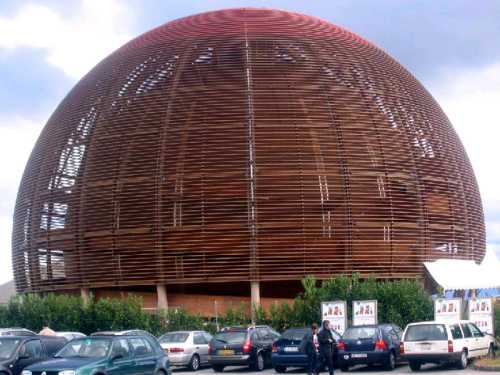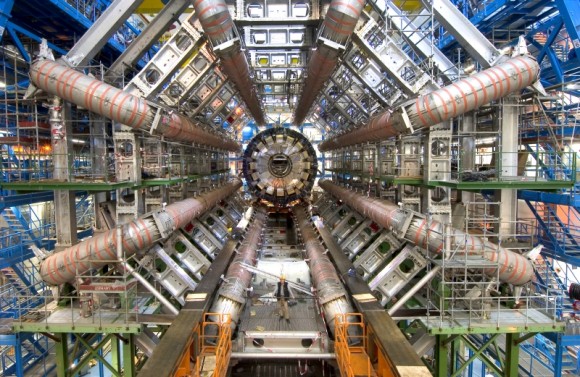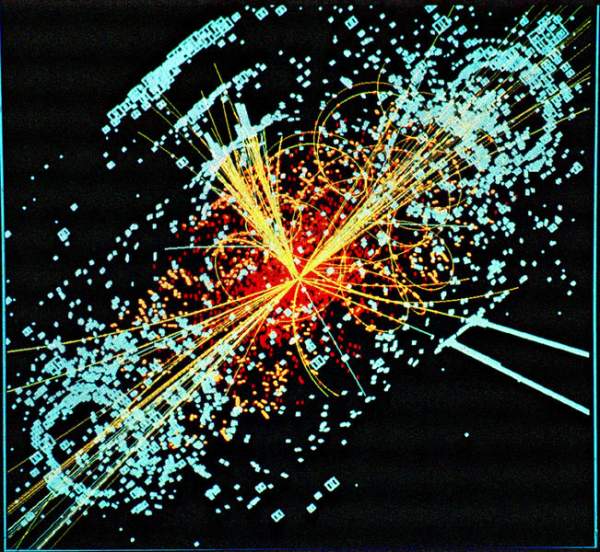The European Organisation for Nuclear Research (CERN), which houses the world's most powerful particle accelerator - the Large Hadron Collider (LHC)- has just announced that scientists have found a new subatomic particle that could be the Higgs boson, the basic building block of the universe.
"I can confirm that a particle has been discovered that is consistent with the Higgs boson theory," said John Womersley, chief executive of Britain's Science & Technology Facilities Council, at an event in London.
''Higgs within reach. Our understanding of the universe is about to change…'' says CERN's official website (http://public.web.cern.ch/public/).
Several websites carried live streaming of the announcement today. According to media reports, speculation on 'God Particle' started when a 'leaked video' was briefly made public yesterday on the website of CERN, confirming that physicists at the LHC have most likely discovered the long-sought particle.


We have compiled a few facts about the Higgs boson particle:
1. The Higgs boson theory explains how particles clumped together to form stars, planets and even life. The scientists claim that without the Higgs particle, particles that make up the universe would have remained like a soup.
2. According to media reports, the Higgs boson is partly named after an Indian scientist Satyendra Nath Bose, who worked with Albert Einstein in the 1920s and made discoveries that led to the particle being named after him.
3. Peter Higgs, a British physicist, in 1964 made further discoveries that lead to the name 'Higgs boson'.
4. Its discovery has validated the Standard Model as essentially correct.
5. The 'God Particle' was a term coined by the media, after the title of Leon Lederman's book on particle physics ''The God Particle: If the Universe Is the Answer, What Is the Question?''. However, scientists dislike the name as they feel it misleads people on what they actually do.
6. If the new particle found is indeed the Higgs boson particle, celebrated British physicist Stephen Hawking will lose a public bet he placed saying that LHC would never find the so called 'God Particle'.
Facts and figures - LHC
The largest machine
in the world...
The
precise circumference of the LHC accelerator is 26 659 m, with a total of 9300
magnets inside. Not only is the LHC the world’s largest particle accelerator,
just one-eighth of its cryogenic distribution system would qualify as the
world’s largest fridge. All the magnets will be pre‑cooled to -193.2°C (80 K) using 10 080 tonnes of liquid
nitrogen, before they are filled with nearly 120 tonnes of liquid helium to
bring them down to -271.3°C (1.9 K).
The fastest racetrack
on the planet...
At
full power, trillions of protons will race around the LHC accelerator ring 11
245 times a second, travelling at 99.9999991% the speed of light. Two beams of
protons will each travel at a maximum energy of 7 TeV (tera-electronvolt),
corresponding to head-to-head collisions of 14 TeV. Altogether some 600 million
collisions will take place every second.
The emptiest space in
the Solar System...
To
avoid colliding with gas molecules inside the accelerator, the beams of
particles travel in an ultra-high vacuum – a cavity as empty as interplanetary
space. The internal pressure of the LHC is 10-13 atm, ten times less than the
pressure on the Moon!
The hottest spots in
the galaxy, but even colder than outer space...
The
LHC is a machine of extreme hot and cold. When two beams of lead ions collide,
they will generate temperatures more than 100 000 times hotter than the heart
of the Sun, concentrated within a minuscule space. By contrast, the 'cryogenic
distribution system', which circulates superfluid helium around the accelerator
ring, keeps the LHC at a super cool temperature of -271.3°C (1.9 K) – even
colder than outer space!
The biggest and most sophisticated
detectors ever built...
To
sample and record the results of up to 600 million proton collisions per
second, physicists and engineers have built gargantuan devices that measure
particles with micron precision. The LHC's detectors have sophisticated
electronic trigger systems that precisely measure the passage time of a
particle to accuracies in the region of a few billionths of a second. The
trigger system also registers the location of the particles to millionths of a
metre. This incredibly quick and precise response is essential for ensuring
that the particle recorded in successive layers of a detector is one and the
same.
The most powerful
supercomputer system in the world...
The
data recorded by each of the big experiments at the LHC will fill around 100
000 dual layer DVDs every year. To allow the thousands of scientists scattered
around the globe to collaborate on the analysis over the next 15 years (the
estimated lifetime of the LHC), tens of thousands of computers located around
the world are being harnessed in a distributed computing network called the
Grid.















0 comments:
Post a Comment
Thanks for commenting